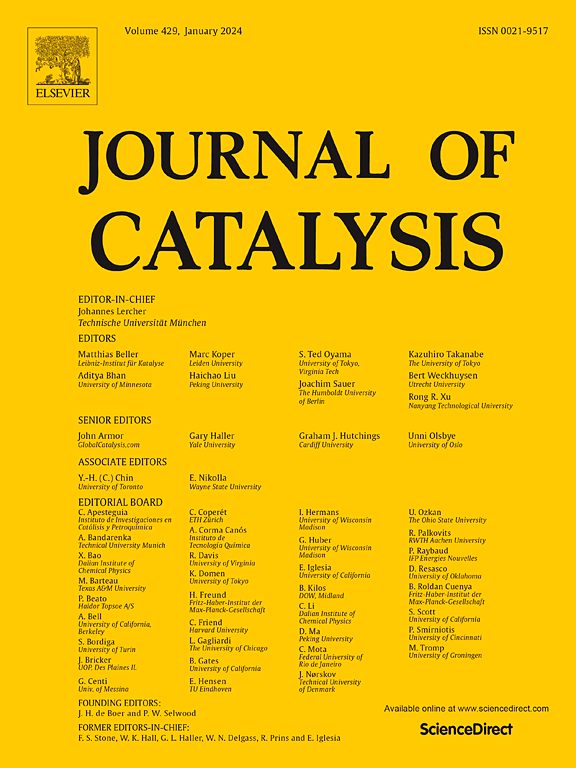Tuning plasmonic reactivity: Influence of nanostructure, and wavelength on the dimerization of 4-NTP
IF 6.5
1区 化学
Q2 CHEMISTRY, PHYSICAL
引用次数: 0
Abstract
Hot electrons generated in plasmonic nanoparticles are considered a key candidate for their ability to promote reduction reactions of organic molecules selectively. Such chemical transformations can occur when molecules are adsorbed on the surface of plasmonic nanoparticles interacting with an external incident electromagnetic field. The so-called localized surface plasmon resonance phenomenon, induced by the electromagnetic field, is responsible for the generation of energetic electrons which in turn can be transferred to the molecule, causing its reduction. It is known that such plasmon-induced hot carrier reactions mainly occur in proximity of the so-called hot spots, areas of the plasmonic particle with enhanced electromagnetic field.
In this study, we discuss the photocatalytic performances via hot-electron transfer of three different silver nanoplatforms (nanospheres, nanoplatelets, and nanoflowers) for the conversion of 4-nitrothiophenol (4-NTP) to dimercaptoazobenzene (DMAB). The reaction was monitored via surface-enhanced Raman spectroscopy (SERS), irradiating the sample with a 532 nm or a 785 nm laser line. In both cases, we noticed a clear correlation between particle morphologies and reaction kinetic, useful for identifying the more favorable silver nanocatalyst. Moreover, measurements carried out by the 785 nm laser radiation revealed an unexpected conversion of 4-NTP to 4-aminothiophenol (4-ATP) on silver nanoflowers in the absence of reducing agents. This innovative approach opens up the interesting possibility of developing plasmonic nanoparticle-based catalysts with sustained performance while reducing the presence of chemical reactants and providing an alternative and cleaner synthetic chemical route.


调谐等离子体反应性:纳米结构和波长对4-NTP二聚化的影响
等离子体纳米粒子中产生的热电子被认为是其选择性促进有机分子还原反应的关键候选者。当分子被吸附在与外部入射电磁场相互作用的等离子体纳米粒子表面时,这种化学转化就会发生。所谓的局部表面等离子体共振现象,由电磁场引起,负责产生高能电子,这些电子反过来可以转移到分子中,导致其减少。众所周知,这种等离子体诱导的热载子反应主要发生在所谓的热点附近,即等离子体粒子具有增强电磁场的区域。在这项研究中,我们讨论了三种不同的银纳米平台(纳米球、纳米片和纳米花)通过热电子转移将4-亚硝基苯酚(4-NTP)转化为 二巯基偶氮苯(DMAB)的光催化性能。通过表面增强拉曼光谱(SERS)监测反应,用532 nm或785 nm激光线照射样品。在这两种情况下,我们注意到颗粒形态和反应动力学之间存在明显的相关性,这有助于确定更有利的银纳米催化剂。此外,通过785 nm激光辐射进行的测量显示,在没有还原剂的情况下,银纳米花上的4-NTP意外地转化为4-氨基噻吩(4-ATP)。这种创新的方法为开发具有持续性能的等离子体纳米粒子催化剂开辟了有趣的可能性,同时减少了化学反应物的存在,并提供了一种替代的、更清洁的合成化学路线。
本文章由计算机程序翻译,如有差异,请以英文原文为准。
求助全文
约1分钟内获得全文
求助全文
来源期刊

Journal of Catalysis
工程技术-工程:化工
CiteScore
12.30
自引率
5.50%
发文量
447
审稿时长
31 days
期刊介绍:
The Journal of Catalysis publishes scholarly articles on both heterogeneous and homogeneous catalysis, covering a wide range of chemical transformations. These include various types of catalysis, such as those mediated by photons, plasmons, and electrons. The focus of the studies is to understand the relationship between catalytic function and the underlying chemical properties of surfaces and metal complexes.
The articles in the journal offer innovative concepts and explore the synthesis and kinetics of inorganic solids and homogeneous complexes. Furthermore, they discuss spectroscopic techniques for characterizing catalysts, investigate the interaction of probes and reacting species with catalysts, and employ theoretical methods.
The research presented in the journal should have direct relevance to the field of catalytic processes, addressing either fundamental aspects or applications of catalysis.
 求助内容:
求助内容: 应助结果提醒方式:
应助结果提醒方式:


